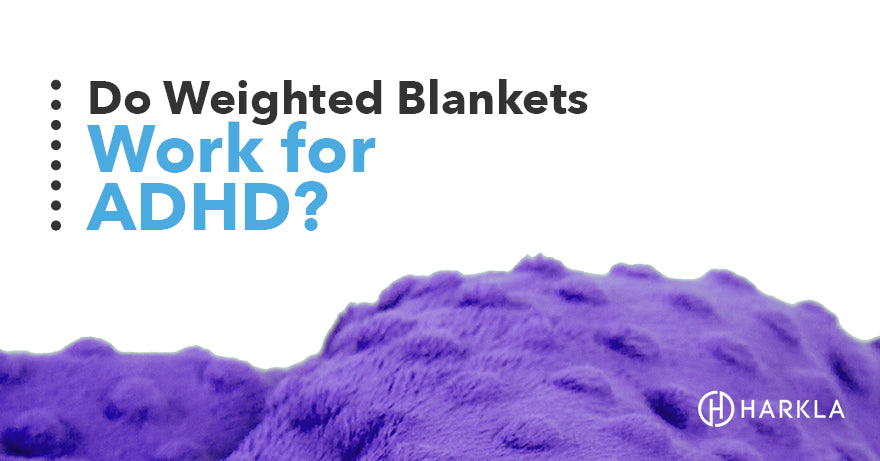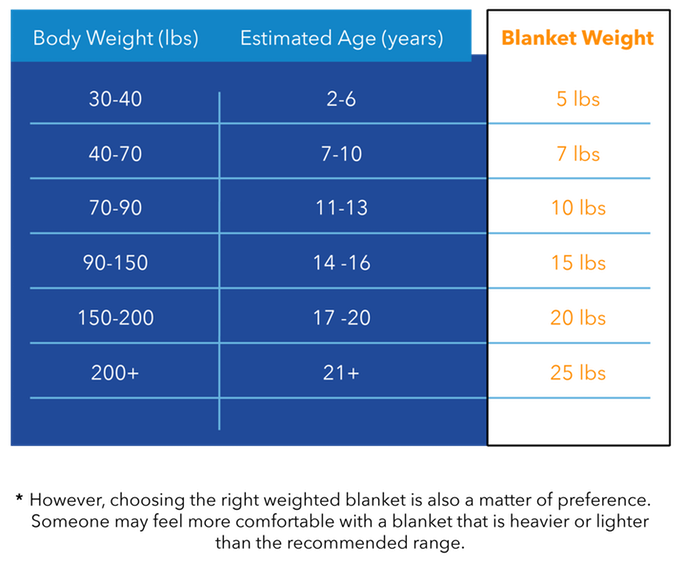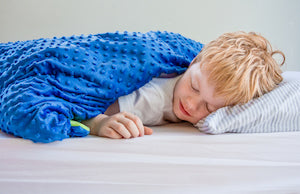Your Cart is Empty
Save up to 20% on all Harkla products & courses during Autism Acceptance Month! Click Here to See the Sale

Weighted blankets have become very popular recently because of the benefits they provide to a wide range of people. They have commonly been used for those with autism, sensory processing disorder, anxiety, or even PTSD.
Even some adults with normal, everyday stress are starting to use them to help with relaxation and to get a healthier night of sleep.
Another common use for weighted blankets are for those with ADHD, and that’s what we’ll be covering in this article. We’ll look at exactly what the benefits of a weighted blanket are for someone with ADHD.
Before we dive into the research let’s take a look at what a weighted blanket is.
A weighted blanket is pretty much what it sounds like… a heavy blanket. However, there are more details to them than simply being heavy.
The first thing to know is that the weight of a blanket should depend upon who is using the blanket. The rule of thumb if 10% of the user’s bodyweight plus a pound or two.
For a 30 pound child, you’d want a 5-pound blanket. For a 150-pound adult, you’d want a 17-pound blanket.

Another common difference in blankets is what is used to weigh them down. Some blankets are filled with rice or millet, while others are filled with poly-pellets or glass beads.
Weighted blankets also differ in what fabric is used. This will depend on what fabric you prefer for a blanket!
So that’s the basics of weighted blankets. Let’s dive into the science of them.
Before we get into the benefits of weighted blankets for those with ADHD, we need to first understand the science behind them.
This science is called deep touch pressure (DTP) and is basically any gentle, distributed pressure on the body. A hug or massage would even count as DTP. Learn more about Deep Touch Pressure here.
Deep Touch Pressure has been shown to calm people’s nervous systems while releasing serotonin in the body.
Serotonin is a chemical in the body that is important for mood, sleep, focus, and feeling calm. Serotonin is a major factor, not only in ADHD, but autism, bi-polar, anxiety, and PTSD.
It’s been shown that those with ADHD are low in serotonin, which is why drugs like Ritalin work, by boosting serotonin levels in the brain. Serotonin is thought to be a key factor in ADHD, which is why DTP could be a great option for those who have it!
Since Deep Touch Pressure is the underlying science of weighted blankets, we’ll also be referencing studies that involve weighted vests. Weighted vests are a great option for those in school or on the go, but a weighted blanket or weighted lap pad could be used for similar effects.
So now let’s get into the benefits of weighted blankets for those with ADHD!
This is usually one of the main problems children with ADHD have. Being able to focus in a classroom environment can be a difficult task.
One study found that children with ADHD were able to focus on their tasks in the classroom 18 to 15% better while they were wearing a weighted vest. Another study supported these findings, showing that weighted vests improve in-seat behavior, attention-to-task, and task completion in children with ADHD.
One study, which referred to DTP as deep pressure stimulation, found that a weighted vest not only improved performance but actually made a physiological change by calming down the subjects’ nervous systems.
In two separate surveys of occupational therapists, it was found that the most common improvement that they see when using weighted vests is an improvement in the classroom, specifically increasing attention span and being able to stay on task.
Like I mentioned these studies reference weighted vests, but the results can be accomplished with different strategies, as long as they use deep touch pressure. A weighted stuffed animal in the lap or a weighted blanket across the shoulders or legs would all have a deep touch pressure effect.
With the above studies, it’s easy to see that a weighted blanket could be used to help a child transition from a high energy activity to a low energy one. An example that I’ve seen used in schools is to have a 5 minute transition time for children coming in from recess.
The teachers gave the children who needed it a few minutes under a weighted blanket to help them transition into the class after being active outside.
This can be used in a number of scenarios in the home. Whether it’s coming in from play to time to do homework or time to wind down for the night and get ready for bed, having your child lay under a weighted blanket will have a calming effect.
This can even work on the go. You could use a weighted blanket in the car to help your child stay calm in the backseat.

This is typically where we see weighted blankets used most for and often times is where the most excitement around them comes from.
ADHD is linked to a number of sleep issues. Children with ADHD have higher rates of daytime sleepiness, sleep disordered breathing, and restless leg syndrome than children without ADHD.
Weighted blankets not only help sleep by calming the nervous system and releasing the calming chemical serotonin but also they help release melatonin. Melatonin is a chemical in the body that tells your body when it’s time to go to bed.
Healthy individuals will naturally release melatonin around the time they usually get to bed. However, for children with ADHD, it may be harder for them to release it on their own. It’s actually been shown that supplementing with melatonin can improve sleep with children with ADHD.
Weighted blankets are actually used to improve sleep for those with restless leg syndrome, which is one of the issues that children with ADHD may have to deal with.
Related, to sleep, Harkla has created sleep supplements for sensitive children. Learn more here.
If you are looking to improve your child’s classroom behavior, transition periods, or sleep, a weighted blanket could a great, drug-free option.
If you have any questions about weighted blankets or can share your experience using one, we’d love to hear about it in the comments!
Hey Brad,
Thanks for your input! One thing to remember about weighted blankets is that they are made smaller in order to focus the most amount of weight on the individual and not on the area surrounding the person. If they are made too big, they won’t have the intended effect. Also, if you were to make a really big weighted blanket, it would have to weigh so much more to provide enough DTP. Let us know if you have any questions!
Take care,
Nicole
Harkla Happiness Ninja
I’m big on weighted blankets. But SIZE is very important. If the blanket is tiny (like the much-hyped Gravity Blanket), it won’t have the intended sleep benefits because it will constantly be falling off. Buyer beware.
Comments will be approved before showing up.



Leverne
November 23, 2021
What is everyone’s opinion on weighted pillows? It is for a child in a care situation, so a blanket isn’t always possible especially with Covid restrictions. There is no nap time.